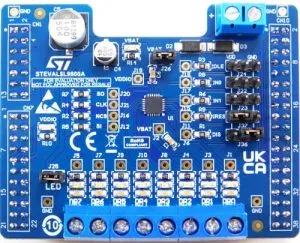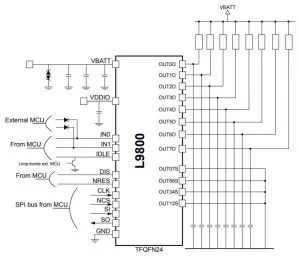The nominal ratings of L9800, as it will be known, are: 12V power rail and 260mA per output.
L9800 outputs can drive resistive, capacitive or inductive loads like relays, solenoids and LEDs,” said ST. “Diagnostic signals are available at the SPI port, which also provides access to the driver’s internal configuration registers for device set-up.”
On top of the diagnostics, there are protections for open-circuit, short-circuit, over-current and over-temperature protection per channel.
Normal operation is across 6 to 18V, then there is more restricted operation from 3 to 6V, and from to 28V, and load dump protection up to 42V. A 5V logic rail is also required.
Current can be as high as 500mA under some circumstances, and a special in-rush mode allows ordinary light bulbs to to 2W to be driven.
Switching instructions for the outputs are expected through the SPI interface interface from a host microcontroller, or alternatively there are two dedicated input pads on the IC that can be mapped to selected outputs.
If the host microcontroller fails, external safety hardware can gain control of two particular output (2 and 3) channels via the same dedicated input pads, even if the chip’s digital supply voltage is not available.
“This lets the L9800 operate in limp-home mode, maintaining essential functions for safety and convenience, in the event of system failure such as a microcontroller fault or supply undervoltage,” said ST.
 Suitable limp-home circuits are provided in the data sheet.
Suitable limp-home circuits are provided in the data sheet.
Packaging is 4 x 4mm TFQFN24, and there is an evaluation board (left).
The company is expecting use in automotive body control, climate and power domain controllers.

